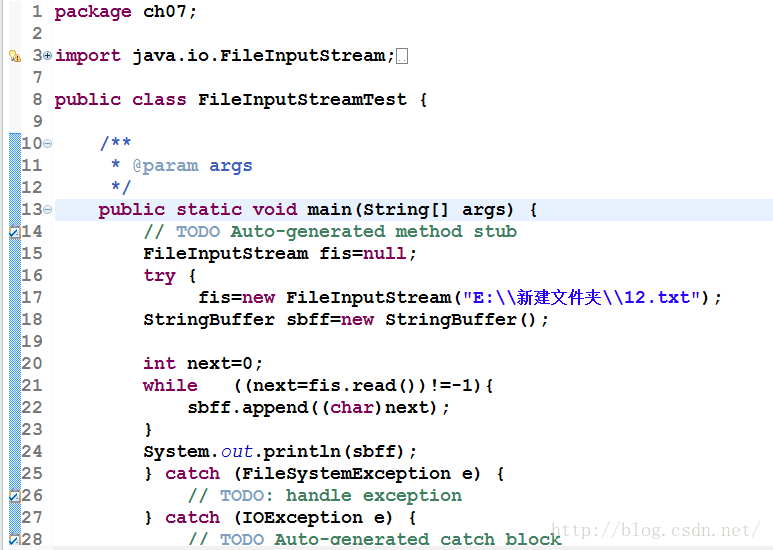JAVA exception异常处理+I/O操作读写文件 笔记
JAVA 异常处理
JAVA的异常5个关键字try...catch...finally..throw..throws
| 捕获异常 | 声明异常 | 抛出异常 | |
| try | 执行可能产生异常的代码 | throws | throw |
| catch | 捕获异常 | 声明方法可能要抛出的的各种异常 | 手动抛出异常 |
| finally | 无论是否发生异常代码总能执行 |
所有异常对象都包含了如下几个常用方法:
getMessage():返回该异常的详细描述字符串。
printStackTrace():将该异常的跟踪栈信息输出到标准错误输出。
printStackTrace(PrintStream s):将该异常的跟踪栈信息输出到指定输出流。
getStackTrace():返回该异常的跟踪栈信息。
try
{
需要检测的代码;
}
catch(异常类 变量)
{
异常处理代码;
}
finally
{
一定会执行的代码;
}
Finally代码块只有一种情况不会被执行。就是在之前执行了System.exit(0)。
异常处理的嵌套
异常处理流程代码可以放在任何能放可执行性代码的地方,因此完整的异常处理流程既可放在try块里,也可放在catch块里,也可放在finally块里。
异常处理嵌套的深度没有很明确的限制,但通常没有必要使用超过两层的嵌套异常处理,层次太深的嵌套异常处理没有太大不要,而且导致程序可读性降低。
I/O操作读写文件
import java.io.File;
……
File file = new File(args[0]);
System.out.println("文件或目录是否存在:" + file.exists());
System.out.println("是文件吗:" + file.isFile());
System.out.println("是目录吗:" + file.isDirectory());
System.out.println("名称:" + file .getName());
System.out.println("路径: " + file.getPath());
System.out.println("绝对路径: " + file.getAbsolutePath());
System.out.println("最后修改时间:" + file.lastModified());
System.out.println(“文件大小:” + file.length()+ “ 字节”);
……
Java的IO流是实现输入/输出的基础,它可以方便地实现数据的输入/输出操作,Java中把不同的输入/输出源(键盘、文件、网络连接等)抽象表述为“流”(stream),通过流的方式允许Java程序使用相同的方式来访问不同的输入/输出源。stream是从起源(source)到接收(sink)的有序数据。
Java把所有传统的个流类型(类或抽象类)都放在java.io包中,用以实现输入/输出功能。
按照流的流向来分:可以分为输入流和输出流。
输入流:只能从中读取数据,而不能向其写出数据。
输出流:只能向其写出数据,而不能从中读取数据。
字节流和字符流
按照流的角色分,可以分为节点流和处理流。
文本文件的读写
用FileInputStream读文件
用FileOutputStream写文件
用BufferedReader读文本文件
用BufferedWriter写文本文件
二进制文件的读写
DataOutputStream
DataInputStream
IO流的四个基类
Java把所有设备里的有序数据抽象成流模型简化了输入/输出的处理。
Java的IO流共涉及到40多个类,这些类看上去芜杂而凌乱,但实际上是非常规则、而且彼此之间存在非常紧密的联系。
Java的IO流的40多个类都是从4个抽象基类派生出来的:
InputStream/Reader:所有输入流的基类,前者是输入字节流,后者是输入字符流。
OutputStream/Writer:所有输出流的基类,前者是输出字节流,后者是输出字符流。
输入流
InputStream和Reader是所有输入流的基类,它们都是两个抽象类,本身并不能创建实例来执行输入,但它们将所谓所有输入流的模板,所以它们的方法是所有输入流都可使用的方法。它们包含如下三个方法:
int read():从输入流中读取单个字节(相当于从图15.5所示水管中取出一滴水),返回所读取的字节数据(字节数据可直接转换为int类型)。
int read(byte[]/char[] b):从输入流中读取最多b.length个字节的数据,并将其存储在字节数组b中,返回实际读取的字节数。
int read(byte[]/char[] b, int off, int len):从输入流中读取最多len字节的数据,并将其存储在数组 b 中,放入b数组中时,并不是从数组起点开始,而是从off位置开始,返回实际读取的字节数。
输出流
OutputStream和Writer也非常相似,它们采用如图15.6所示的模型来执行输出,两个流都提供了如下三个方法:
void write(int c):将指定的字节/字符输出到输出流中,其中c既可以代表字节,也可以代表字符。
void write(byte[]/char[] buf):将字节数组/字符数组中的数据输出到指定输出流中。
void write(char[] cbuf, int off, int len):将字节数组/字符数组中从off位置开始,长度为len的字节/字符输出到输出流中。
package ch07;
import java.io.FileInputStream;
import java.io.FileNotFoundException;
import java.io.IOException;
import java.nio.file.FileSystemException;
public class FileInputStreamTest {
/**
* @param args
*/
public static void main(String[] args) {
// TODO Auto-generated method stub
FileInputStream fis=null;
try {
fis=new FileInputStream("E:\\新建文件夹\\12.txt");
StringBuffer sbff=new StringBuffer();
int next=0;
while ((next=fis.read())!=-1){
sbff.append((char)next);
}
System.out.println(sbff);
} catch (FileSystemException e) {
// TODO: handle exception
} catch (IOException e) {
// TODO Auto-generated catch block
e.printStackTrace();
}finally{
try {
fis.close();
} catch (IOException e) {
// TODO Auto-generated catch block
e.printStackTrace();
}
}
}
}

package ch07;
import java.io.FileInputStream;
import java.io.FileNotFoundException;
import java.io.IOException;
public class FileInputStreamTest2 {
/**
* @param args
*/
public static void main(String[] args) {
// TODO Auto-generated method stub
FileInputStream fis=null;
try {
fis=new FileInputStream("E:\\新建文件夹\\12.txt");
byte[] b=new byte[30];
StringBuffer sbff=new StringBuffer();
while(fis.read(b)!=-1){
sbff.append(new String(b));
}
System.out.println(sbff);
} catch (FileNotFoundException e) {
// TODO Auto-generated catch block
e.printStackTrace();
} catch (IOException e) {
// TODO Auto-generated catch block
e.printStackTrace();
}
}
}
读某文件夹里内容
在文件里写内容
package ch07;
import java.io.FileNotFoundException;
import java.io.FileOutputStream;
import java.io.IOException;
public class FilOutputStreamTest {
/**
* @param args
*/
public static void main(String[] args) {
// TODO Auto-generated method stub
FileOutputStream fos = null;
String name = "E:\\新建文件夹\\1234.txt";
try {
fos = new FileOutputStream(name); //清空后加(name)//追加(name,true)
String str = "dhahashdsd中国";
fos.write(str.getBytes());
} catch (FileNotFoundException e) {
// TODO Auto-generated catch block
e.printStackTrace();
} catch (IOException e) {
// TODO Auto-generated catch block
e.printStackTrace();
}
finally{
try {
fos.flush();
fos.close();
} catch (IOException e) {
// TODO Auto-generated catch block
e.printStackTrace();
}
}
}
}

![]() 复制文字
复制文字![]()
package ch07;
import java.io.FileInputStream;
import java.io.FileNotFoundException;
import java.io.FileOutputStream;
import java.io.IOException;
public class InputOuput {
/**
* @param args
*/
public static void main(String[] args) {
// TODO Auto-generated method stub
FileInputStream fis=null;
FileOutputStream fos = null;
String inputname = "E:\\新建文件夹\\1234.txt";
String ouputname = "E:\\新建文件夹\\123455.txt";
try {
fis=new FileInputStream(inputname);
fos = new FileOutputStream(ouputname);
byte[] b=new byte[3000];
StringBuffer sbff=new StringBuffer();
while(fis.read(b)!=-1){
sbff.append(new String(b));
}
String str = sbff.toString();
fos.write(str.getBytes());
} catch (FileNotFoundException e) {
// TODO Auto-generated catch block
e.printStackTrace();
} catch (IOException e) {
// TODO Auto-generated catch block
e.printStackTrace();
}finally{try {
fis.close();
fos.flush();
fos.close();
} catch (IOException e) {
// TODO Auto-generated catch block
e.printStackTrace();
}
}
}
}
![]() 复制图片
复制图片![]()
package ch07;
import java.io.FileInputStream;
import java.io.FileNotFoundException;
import java.io.FileOutputStream;
import java.io.IOException;
import java.io.OutputStream;
public class inputouputtupian {
/**
* @param args
*/
public static void main(String[] args) {
// TODO Auto-generated method stub
FileInputStream fis=null;
FileOutputStream fos = null;
String inputname = "E:\\新建文件夹\\123.jpg";
String ouputname = "E:\\新建文件夹\\123455.jpg";
try {
fis=new FileInputStream(inputname);
fos = new FileOutputStream(ouputname);
//byte[] b=new byte[3000000];
//StringBuffer sbff=new StringBuffer();
int next=0;
while((next=fis.read())!=-1){
fos.write(next);
}
// String str = sbff.toString();
// fos.write(str.getBytes());
} catch (FileNotFoundException e) {
// TODO Auto-generated catch block
e.printStackTrace();
} catch (IOException e) {
// TODO Auto-generated catch block
e.printStackTrace();
}
finally{try {
fis.close();
fos.flush();
fos.close();
} catch (IOException e) {
// TODO Auto-generated catch block
e.printStackTrace();
}
}
}
}

作者:冲天之峰 20160603








